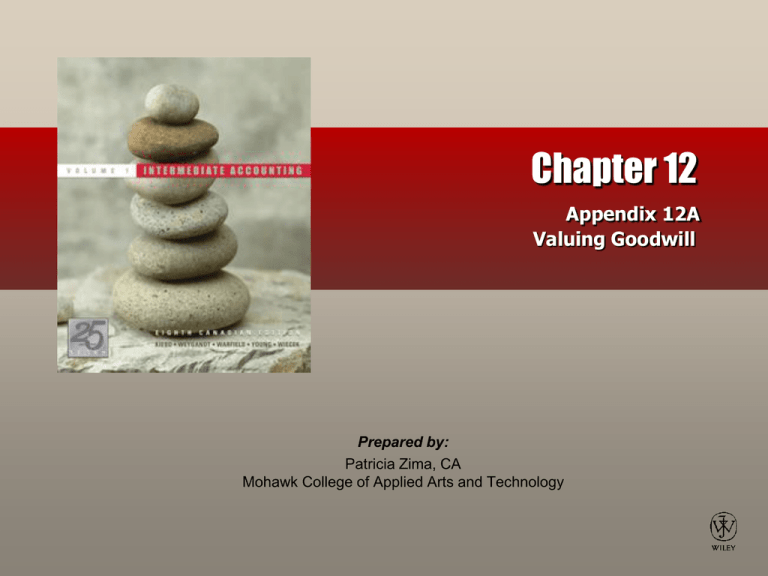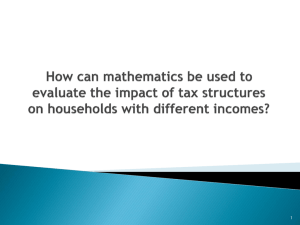
Chapter 12
Appendix 12A
Valuing Goodwill
Prepared by:
Patricia Zima, CA
Mohawk College of Applied Arts and Technology
The Excess Earnings Approach
A widely used method to estimate goodwill in a
business is the excess-earnings approach
Steps:
1. Calculate company’s expected annual
average “normalized” earnings
2. Calculate annual average earnings if
company earned same return as the
industry average
3. Calculate company’s excess earnings
4. Estimate the value of goodwill based on
excess earnings
2
Company’s Average
“Normalized” Earnings
Given the following for Tractorling Corp.:
Identifiable net assets (FV): $ 350,000
Earnings history (2003–2007):
2003: $ 60,000
2004: $ 55,000
2005: $110,000
2006: $ 70,000
2007: $ 80,000
Total earnings for the five years = $375,000
3
Company’s Average
“Normalized” Earnings
Average earnings:
$375,000 = $75,000
5 years
We now need to normalize the earnings for
Tractorling Corp.
4
Company’s Average
“Normalized” Earnings
• Normalized earnings is representative of
future earnings
• Accounting policies applied should be
consistent with that of the purchaser
• Future earnings should be based on fair
value of the net assets rather than the
carrying amount of the net assets
• Non-recurring amounts are adjusted out
(e.g., extraordinary gains/losses, unusual
items)
5
Company’s Average
“Normalized” Earnings
Average previous earnings
Add:
Adjust for Inventory
$2,000
Adjust for Amortization
3,000
Less:
Average Extraordinary
Gain
5,000
Patent amortization
1,000
Expected Future Earnings
$75,000
5,000
80,000
6,000
$74,000
6
Average Earnings Using Industry
Average
• Expected earnings without goodwill
• Industry average rate of return: 15%
Fair value of net identifiable assets
Industry average rate of return
Normal earnings (if no goodwill)
$350,000
15%
$ 52,500
7
Excess Earnings
Expected future earnings
Normal earnings
Excess earnings
$74,000
52,500
$21,500
Excess earnings must now be discounted to
their present value
8
Discount Rate
Higher discount rate normally used:
– discounting future cash inflows that may be
riskier
– higher discount rate will lower goodwill
Factors to consider when determining
discount rate:
– Stability of past earnings
– Speculative nature of business
– General economic conditions
9
Discount Period
• Discount period based on:
– Professional judgement
– Estimation of how long the excess earnings
are expected to last
10
Value of GoodwillExcess-Earnings Approach
Rate of return required by purchaser = 15%
Discount period = perpetuity
Expected earnings = $74,000
Normal return
= $52,500
Excess earnings = $21,500
Goodwill
= $143,333
= $ 21,500 ÷ 0.15
11
Total-Earnings Approach
• Total-earnings approach is an alternative
approach to estimating goodwill
• The value of the company as a whole is
determined
• Based on total expected earnings
• Fair value of identifiable net assets deducted
from the value of the company
• Difference is goodwill
12
Total-Earnings Approach
Goodwill = Fair value of
company
– Fair value of
identifiable net assets
FV of Co. = $74,000 ÷ 0.15 = $ 493,333
FV of identifiable net assets
Goodwill
350,000
$ 143,333
13
Other Valuation Methods
• Number of Years Method
– Excess earnings multiplied by the number of
years excess earnings expected to last
– Advantage: simple
– Disadvantage: does not consider time value
of money
14
Other Valuation Methods
• Discounted Free Cash Flow Method
– Project the free cash flow over a 10–20
year period
– Free cash flow: that amount of cash from
operations in excess of what is needed to
maintain existing capacity
– Discount this amount
– Result is the value of the business
15
COPYRIGHT
Copyright © 2007 John Wiley & Sons Canada, Ltd.
All rights reserved. Reproduction or translation of
this work beyond that permitted by Access Copyright
(The Canadian Copyright Licensing Agency) is
unlawful. Requests for further information should be
addressed to the Permissions Department, John
Wiley & Sons Canada, Ltd. The purchaser may make
back-up copies for his or her own use only and not
for distribution or resale. The author and the
publisher assume no responsibility for errors,
omissions, or damages caused by the use of these
programs or from the use of the information
contained herein.
16







